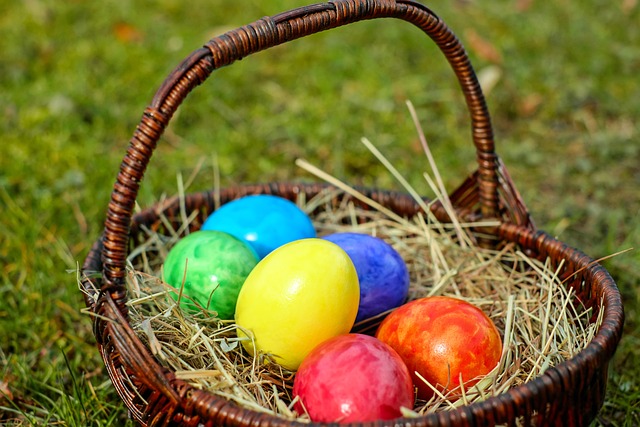Spring Break is a big deal. This year about 1.5 million US college students will travel during Spring Break. They will spend, on average, about $1080 dollars each. Some businesses report that 15-20 percent of their yearly tourism income comes from this. Miami authorities this year are responding to the influx of partygoers by imposing a curfew on the weekends, and some businesses are upset. But the authorities maintain this is necessary for the public safety. Not all traditions are good ones, but we still do them.
What about Easter? What are your traditions there? Some churches have sunrise services. I went to one in a cemetery once. And then there are Easter egg coloring activities and egg hunts. Some people have the Easter bunny visit them with special toys or candy put into colorful baskets. And a lot of people eat a special meal with family, much like for Thanksgiving, except ham is often the featured meat.
Where do these traditions come from? For that matter, where does the word “Easter” come from? It isn’t biblical at all. It comes from Eostre, an ancient Anglo-Saxon goddess associated with springtime and fertility. There is a legend that Eostre saved a bird whos wings were frozen by transforming it into a hare. The hare gave thanks by returning each year during the springtime festival to lay colored eggs.
It’s easy to see why eggs and bunnies are so prominent around Easter. They are both symbols of springtime and fertility. Ham is popular because pork was the meat that was ready in the early spring, after hogs were slaughtered in the fall and left to cure all winter.
Christians adopted the springtime holiday and made it their own. After all, there is another story of rebirth to tell. But most of the traditions around Easter have nothing to do with Christianity. They also differ depending on what part of the world you live in. In Sweden kids go trick-or-treating the night of Maundy Thursday. This is tied to an old belief that witches flew on their broomsticks to be with the devil on that day. Kids in parts of Sweden and Finland dress up as witches and ask for candy, going from house to house.
Australia ditched the Easter bunny for the indigenous bilby, a marsupial with long ears native to the continent. You can get chocolate bilbies there. In Hungary they have a tradition of throwing water on young women the day after Easter.
If you think these traditions are strange you a probably right. But your traditions are most likely strange to others too. They are only strange if they aren’t your traditions.
Why do we need traditions? Or do we need them at all? Can’t we just celebrate the risen Christ at church during a morning service and call it a day? It turns out that traditions are actually very good for a society. They give us predictability and stability in our lives. We know what is coming and we know how to prepare. They also help us to keep culture alive. We define ourselves by what we do, and that is all about culture. Traditions help foster that. They can bring families together. My family has a tradition of breaking open a pinata on New Years Day. Most people don’t do this but it is a nice tradition that brings us together and gives us something to look forward to.
But I think the best reason for a tradition is that it brings the day out of the ordinary and makes things memorable. Without Thanksgiving no one would remember the events of the fourth Thursday in November. I once talked to a minister that had an important spiritual conversation with his son. He decided to take his son outside to their back yard while they talked. While there they turned over stones in the yard. There was no practical reason for this, but it made the event memorable.
Easter traditions are colorful, happy, and fun. They bring us together. They make it easy for us to remember the season, to share the Good News of Christ’s resurrection with each other and with the world.
God Bless

